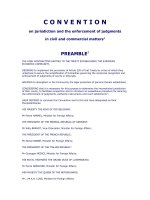Increasing Aircraft Carrier Forward Presence - Changing the Length of the Maintenance Cycle pdf
Bạn đang xem bản rút gọn của tài liệu. Xem và tải ngay bản đầy đủ của tài liệu tại đây (555.28 KB, 92 trang )
This document and trademark(s) contained herein are protected by law as indicated
in a notice appearing later in this work. This electronic representation of RAND
intellectual property is provided for non-commercial use only. Unauthorized
posting of RAND PDFs to a non-RAND Web site is prohibited. RAND PDFs are
protected under copyright law. Permission is required from RAND to reproduce,
or reuse in another form, any of our research documents for commercial use. For
information on reprint and linking permissions, please see RAND Permissions.
Limited Electronic Distribution Rights
Visit RAND at www.rand.org
Explore the RAND National Defense
Research Institute
View document details
For More Information
This PDF document was made available
from www.rand.org as a public service of
the RAND Corporation.
6
Jump down to document
THE ARTS
CHILD POLICY
CIVIL JUSTICE
EDUCATION
ENERGY AND ENVIRONMENT
HEALTH AND HEALTH CARE
INTERNATIONAL AFFAIRS
NATIONAL SECURITY
POPULATION AND AGING
PUBLIC SAFETY
SCIENCE AND TECHNOLOGY
SUBSTANCE ABUSE
TERRORISM AND
HOMELAND SECURITY
TRANSPORTATION AND
INFRASTRUCTURE
WORKFORCE AND WORKPLACE
The RAND Corporation is a nonprofit
research organization providing
objective analysis and effective
solutions that address the challenges
facing the public and private sectors
around the world.
Purchase this document
Browse Books & Publications
Make a charitable contribution
Support RAND
This product is part of the RAND Corporation monograph series.
RAND monographs present major research findings that address the
challenges facing the public and private sectors. All RAND mono-
graphs undergo rigorous peer review to ensure high standards for
research quality and objectivity.
Roland J. Yardley, James G. Kallimani,
John F. Schank, Clifford A. Grammich
Prepared for the United States Navy
Approved for public release; distribution unlimited
NATIONAL DEFENSE RESEARCH INSTITUTE
Increasing Aircraft
Carrier Forward
Presence
Changing the Length of
the Maintenance Cycle
The RAND Corporation is a nonprofit research organization providing
objective analysis and effective solutions that address the challenges
facing the public and private sectors around the world. RAND’s
publications do not necessarily reflect the opinions of its research clients
and sponsors.
R
®
is a registered trademark.
© Copyright 2008 RAND Corporation
All rights reserved. No part of this book may be reproduced in any
form by any electronic or mechanical means (including photocopying,
recording, or information storage and retrieval) without permission in
writing from RAND.
Published 2008 by the RAND Corporation
1776 Main Street, P.O. Box 2138, Santa Monica, CA 90407-2138
1200 South Hayes Street, Arlington, VA 22202-5050
4570 Fifth Avenue, Suite 600, Pittsburgh, PA 15213-2665
RAND URL:
To order RAND documents or to obtain additional information, contact
Distribution Services: Telephone: (310) 451-7002;
Fax: (310) 451-6915; Email:
Cover photo courtesy of the U.S. Navy
The research described in this report was prepared for the United States
Navy. The research was conducted in the RAND National Defense
Research Institute, a federally funded research and development center
sponsored by the Office of the Secretary of Defense, the Joint Staff,
the Unified Combatant Commands, the Department of the Navy,
the Marine Corps, the defense agencies, and the defense Intelligence
Community under Contract W74V8H-06-C-0002.
Library of Congress Cataloging-in-Publication Data
Increasing aircraft carrier forward presence : changing the length of the maintenance
cycle / Roland J. Yardley [et al.].
p. cm.
Includes bibliographical references.
ISBN 978-0-8330-4407-5 (pbk. : alk. paper)
1. Aircraft carriers—United States—Maintenance and repair. 2. United States.
Navy—Operational readiness. I. Yardley, Roland J.
V874.3.I53 2008
359.9'4835—dc22
2008008899
iii
Preface
Aircraft carriers are a powerful and versatile element of U.S. naval
forces. ey allow the Navy to undertake a wide range of tasks, such
as bringing airpower to bear against opponents, deterring adversaries,
engaging friends and allies, and providing humanitarian assistance.
Aircraft carriers, like other naval ships, go through a cycle of training
to gain and sustain readiness, deploy to a forward theater, return from
deployment, and maintain readiness to surge (i.e., to get underway to
provide additional forward presence as requested by theater command-
ers). ey also undergo scheduled maintenance at shipyards. Because
carriers are among the most complex weapon systems operated by the
Navy, their crews require a great deal of training and the ships demand
extensive maintenance.
Depot maintenance periods consist of large and complicated work
packages. e duration of maintenance periods, the type of mainte-
nance required, and maintenance period scheduling affect the carrier
fleet in numerous ways. Because personnel tempo policies have limited
carriers to just one 6-month deployment per cycle, the length of that
cycle affects the carrier’s operational availability. While longer cycles
could decrease the proportion of time a carrier is in maintenance and
increase its operational availability, longer cycles with only one deploy-
ment per cycle effectively decrease the time a carrier is deployed.
In recent years, the Navy has lengthened the duration of the main-
tenance cycle for carriers, effectively trading actual deployment time
for time that a carrier is not deployed but is able to surge. is tradeoff
iv Increasing Aircraft Carrier Forward Presence
has made it difficult for the Navy to satisfy the combatant command-
ers’ need for sustained carrier presence in their theaters of operation.
Recognizing this problem, the Assessments Division of the
Deputy Chief of Naval Operations for Resources, Requirements, and
Assessments (OPNAV N81) asked RAND to examine the feasibil-
ity and implications of increasing the forward presence of carriers by
examining alternative cycles, including two deployments per cycle,
and their impact on major depot maintenance work without chang-
ing deployment policies. is monograph describes the research find-
ings. It should be of interest to Navy organizations concerned about
the operations and maintenance of naval ships, especially of aircraft
carriers.
e research was sponsored by OPNAV N81 and conducted
within the Acquisition and Technology Policy Center of the RAND
National Defense Research Institute, a federally funded research and
development center sponsored by the Office of the Secretary of Defense,
the Joint Staff, the Unified Combatant Commands, the Department
of the Navy, the Marine Corps, the defense agencies, and the defense
Intelligence Community.
For more information on RAND’s Acquisition and Technology
Policy Center, contact the Director, Philip Antón. He can be reached by
email at ; by phone at 310-393-0411, extension
7798; or by mail at the RAND Corporation, 1776 Main Street, Santa
Monica, California 90407-2138. More information about RAND is
available at www.rand.org.
vv
Contents
Preface iii
Figures
vii
Tables
ix
Summary
xi
Acknowledgements
xvii
Abbreviations
xix
CHAPTER ONE
Introduction 1
Background
1
e Challenge
2
Analytical Approach
3
Organization of the Monograph
4
CHAPTER TWO
Past, Current, and Potential Carrier Cycles 5
e U.S. Carrier Fleet
5
Initial Maintenance Cycles for Nimitz-Class Carriers
7
Introduction of the Fleet Response Plan
9
Recent Changes to the FRP Cycle Length
11
Meeting Forward-Presence Demands
12
Potential Cycles for Evaluation
13
Recent Navy Decisions to Meet Presence Requirements
17
Technical Feasibility of the Potential Cycles
19
vi Increasing Aircraft Carrier Forward Presence
CHAPTER THREE
e Impact of Different Cycles on Operational Availability 21
Relationship Between Cycle Length and Operational Readiness
21
Application of Alternative Cycles to the Carrier Fleet
25
CHAPTER FOUR
e Impact of Different Cycles on the Maintenance
Industrial Base
31
Estimating the Magnitude of Depot Work Packages
32
Impact on the Depots
42
Norfolk Naval Shipyard
42
Puget Sound Naval Shipyard
45
CHAPTER FIVE
Findings and Recommendations 49
APPENDIX
Workload Graphs for the Norfolk and Puget Sound Naval
Shipyards
55
Bibliography
67
vii
Figures
S.1. e Impact of Different Maintenance Cycles on the
Operational Availability of a Notional Carrier
xiii
2.1. Comparison of EOC and IMP Cycles for a Notional
Nuclear Carrier
8
2.2. Average Number of Months Between Start of Nimitz-Class
Depot Availabilities (1977–2005)
11
2.3. Alternative One-Deployment Cycles
15
2.4. Notional Nimitz-Class Maintenance Cycles Before
RCOH
17
3.1. Percentage of Time a Notional Carrier Is Deployed or
Deployable in 30 Days by Cycle Length (One-Deployment
Cycles Only)
22
3.2. Percentage of Time a Notional Carrier Is Deployed or
Deployable in 30 Days by Cycle Length (Two-Deployment
Cycles Only)
23
3.3. Percentage of Time a Notional Carrier Is Deployed or
Deployable in 90 Days or Better (MSS+) by Cycle Length and
Number of Deployments per Cycle
24
3.4. Current 32-Month Cycle Applied to the Fleet
26
3.5. 18/24-Month Cycle Applied to the Fleet
27
3.6. 36/42-Month Cycle Applied to the Fleet
28
3.7. 42-Month Cycle Applied to the Fleet
28
4.1. Breakout of Typical Carrier Depot Work Package Content
36
4.2. Total Workload at NNSY: 18/24-Month Cycle
42
4.3. Total Workload at NNSY: 42-Month Cycle
43
4.4. Total Workload at PSNSY: 18/24-Month Cycle
46
4.5. Total Workload at PSNSY: 42-Month Cycle
47
viii Increasing Aircraft Carrier Forward Presence
5.1. Summary Operational Measures for 18/24-, 32-, and 42-Month
Cycles (Over the Life of a Notional Carrier)
50
5.2. e Impact of Different PIA Durations on the Operational
Availability of a Notional Carrier
52
A.1. Total Workload for 18/24-Month Carrier Cycle—NNSY
55
A.2. Total Workload for 24-Month Carrier Cycle—NNSY
56
A.3. Total Workload for 27-Month Carrier Cycle—NNSY
57
A.4. Total Workload for 32-Month Carrier Cycle—NNSY
58
A.5. Total Workload for 36/42-Month Carrier Cycle—NNSY
59
A.6. Total Workload for 42-Month Carrier Cycle—NNSY
60
A.7. Total Workload for 18/24-Month Carrier Cycle—PSNSY
61
A.8. Total Workload for 24-Month Carrier Cycle—PSNSY
62
A.9. Total Workload for 27-Month Carrier Cycle—PSNSY
63
A.10. Total Workload for 32-Month Carrier Cycle—PSNSY
64
A.11. Total Workload for 36/42-Month Carrier Cycle—PSNSY
65
A.12. Total Workload for 42-Month Carrier Cycle—PSNSY
66
ix
Tables
S.1. e Effects of Cycles Shorter or Longer an the Baseline
32-Month Maintenance Cycle
xvi
2.1. Current and Planned U.S. Navy Aircraft Carrier Fleet
6
2.2. Summary of Changes to the U.S. Navy’s PERSTEMPO
Program
19
3.1. Summary Operational Measures for Various Cycles:
Notional Carrier
24
3.2. FRP Metrics for Various Cycles: Carrier Fleet,
FY 2007–2025
25
4.1. Notional Work Packages for 24-, 27-, and 32-Month
Cycles
33
4.2. Deployments and Underway Days During a Carrier’s Life
37
4.3. Estimates of PIA/DPIA Workloads for 18/24-, 36/42-, and
42-Month Cycles
38
4.4. Work Package Estimates for Different Cycles
40
4.5. Comparison of Different Cycles: NNSY
45
4.6. Comparison of Different Cycles: PSNSY
48
xi
Summary
e U.S. Navy currently maintains a fleet of 11 aircraft carriers. ese
ships, which are among the most powerful and versatile elements of
U.S. naval forces, allow the Navy to undertake a wide range of tasks.
ey are also among the most complex weapon systems operated
by the Navy. e carriers themselves need continuous and regularly
scheduled maintenance. eir crews require a great deal of training to
attain and sustain readiness levels. e length of the training, readi-
ness, deployment, and maintenance cycle (defined as the period from
the end of one depot maintenance period to the end of the next), the
type of maintenance needed (i.e., docking or non-docking), and the
timing of events within the cycle affect the carrier’s availability to meet
operational needs.
e length of the cycle for aircraft carriers has changed several
times in the last two decades. Currently, the Navy uses a 32-month
cycle. is cycle has increased a carrier’s ability to provide additional
forward presence as requested by theater commanders (this additional
presence is called “surge”). However, the combination of a 32-month
cycle length with the personnel tempo policy limit of one 6-month
deployment per cycle has reduced the proportion of time that a carrier
is deployed. e reduction in the percentage of time that each carrier
is deployed, coupled with the decrease in the number of carriers in the
fleet, makes it difficult for operational planners to meet the forward-
presence requirements of theater commanders.
Recognizing the challenge, the Navy asked RAND to assess the
implications of different cycle lengths and their effect on the forward
xii Increasing Aircraft Carrier Forward Presence
presence of Nimitz-class aircraft carriers. We assume a deployment
length of six months and, in accordance with personnel policies in
place under the 32-month cycle, also assume that the time between
deployments will equal twice the length of the previous deployment.
We assess several one-deployment cycles as well as potential two-
deployment options. We also analyze the impact of different cycles on
managing shipyard workloads.
Cycles and Operational Availability
Given a fixed number of months for scheduled maintenance, deploy-
ments, and the time between deployments, Navy planners face a three-
sided tradeoff in setting a carrier’s cycle length. ey must balance the
goals of
deploying carriers and generating forward presencet
holding carriers in reserve and keeping them surge-ready to meet t
emerging needs
maintaining the materiel condition of the ships.t
is is a zero-sum tradeoff in which improving one goal can
adversely affect the others. Under the current 32-month, one-
deployment cycle, for example, a carrier is deployed 19 percent of the
time, at Major Combat Operations–Surge (MCO-S)/Major Combat
Operations–Ready (MCO-R) status (i.e., able to deploy within 30
days) 46 percent of the time, at Maritime Security Surge (MSS) status
(i.e., able to deploy within 90 days) 11 percent of the time, and in
depot maintenance 24 percent of the time. is is depicted in the third
column of Figure S.1. is carrier thus contributes to the “6+1” fleet
response plan goal by being available to serve as one of the six ships 65
percent of the time and as the seventh ship 11 percent of the time.
1
1
is goal is to have at least six carriers deployed (or able to deploy) within 30 days, and a
seventh carrier deployed (or able to deploy) within 90 days.
Summary xiii
Reducing the cycle length to 18 months increases deployment to
31 percent of the time but decreases MSS or higher readiness to 33 per-
cent. It also increases the time in scheduled maintenance to 36 percent
of a carrier’s life. is is depicted in the second column of Figure S.1.
Lengthening the cycle to 42 months and adding a second deploy-
ment in the cycle results in a carrier being deployed 29 percent of the
time and at MSS or higher readiness an additional 53 percent of the
time. is is depicted in the fourth column of Figure S.1. is would
allow the fleet to meet the 6+1 fleet goal 100 percent of the time.
Reducing the length of PIAs for depot maintenance repair from six
to four months—as may be possible under a cycle featuring 18 months
between PIAs (i.e., in an 18/24-month cycle)—increases the propor-
tion of time a ship is able to surge. is is shown in the first column
of Figure S.1. Alternatively, extending the length of PIAs—as may be
Figure S.1
The Impact of Different Maintenance Cycles on the Operational
Availability of a Notional Carrier
NOTE: PIA = planned incremental availability. DPIA = docking planned incremental
availability.
RAND MG706-S.1
Percentage of time in each state
90
40
30
20
10
100
Cycle
0
18/24-mo.
(4-mo. PIA,
10.5-mo.
DPIA)
18/24-mo.
(6-mo. PIA,
10.5-mo.
DPIA)
32-mo.
(6-mo. PIA,
10.5-mo.
DPIA)
42-mo.
(6-mo. PIA,
10.5-mo.
DPIA)
42-mo.
(8-mo. PIA,
12-mo.
DPIA)
80
70
60
50
In maintenance
MSS
(deployable
within 90 days)
MCO-S/MCO-R
(deployable
within 30 days)
Deployed
States
xiv Increasing Aircraft Carrier Forward Presence
required under a 42-month cycle—reduces the amount of time a ship
is able to surge. e fifth column of Figure S.1 shows a 42-month cycle
with an 8-month depot maintenance period. Extending the mainte-
nance period beyond a 6-month duration increases training time and
decreases the amount of time a carrier is able to surge.
Cycles and Shipyard Workload
We also assessed the technical feasibility of maintenance cycles shorter or
longer than the current 32-month cycle. Prior to the current 32-month
cycle, Nimitz-class carriers operated on 24–27 month cycles. is sug-
gests that shorter cycles, by offering more frequent opportunities to
accomplish depot work, are technically feasible. Shorter cycles may also
help level-load work at the shipyards, with more frequent depot visits
resulting in smaller work packages.
Norfolk Naval Shipyard and Puget Sound Naval Shipyard are
the two public shipyards that perform depot-level maintenance for air-
craft carriers during availabilities. ese shipyards can efficiently exe-
cute approximately 30,000 man-days per month during a typical avail-
ability in the 32-month, one-deployment cycle. We assume that the
PIAs for the 18/24-month, one-deployment cycle would range from
15,000–25,000 man-days per month. As such, they could, perhaps, be
accomplished within four months, as suggested above.
Extending the maintenance cycle beyond the current 32 months
raises several questions of feasibility. Certain maintenance tasks must
be performed at specified times to ensure that a carrier reaches its oper-
ational life of approximately 50 years. Some of these tasks could per-
haps be performed earlier or later than currently planned; engineering
studies, such as those conducted when the cycle was extended from 27
to 32 months, would be required should the Navy consider extend-
ing the cycle beyond 32 months. Some of the longer, two-deployment
cycles could require that up to 375,000 man-days of work be accom-
plished within a 6-month availability—this amount of work is more
than twice what Navy depots could be expected to accomplish in that
Summary xv
period of time. is could require extension of the PIA beyond the
nominal six months, as noted above.
Longer cycles with large work packages lead to larger peaks and
deeper valleys in the carrier workload at a shipyard. ese peaks and
valleys make it difficult to efficiently manage the depot workforce and
can lead to higher workforce costs. e longer, two-deployment cycles
could result in long periods (of several months to more than a year)
when there are no carriers at a shipyard for depot maintenance. ese
gaps could lead to a loss of learning or currency in maintenance tasks
that are performed infrequently. is loss of learning could increase the
size of the work packages and lead to higher costs.
Stretching depot availabilities beyond their notional lengths to
handle larger workloads could help level-load the shipyard, but would
also require more training (or retraining) for the ship’s crew after main-
tenance. Extended maintenance and training would reduce the time a
ship is at MCO-S or higher readiness, thereby negating a chief advan-
tage of the longer, two-deployment cycles.
Findings and Recommendations
On balance, our analysis suggests that shortening the one-deployment
cycle will increase the forward presence of the carrier fleet but reduce
its ability to meet the 6+1 fleet goal. Table S.1 summarizes the advan-
tages and disadvantages of each notional cycle examined above.
Shorter cycles may help level workloads at the shipyards. While
longer, two-deployment cycles may increase forward presence while sus-
taining higher levels of readiness for longer periods of time, they could
complicate workforce management at public shipyards. e Navy’s
30-day continuous maintenance availabilities between deployments
may not provide the deep maintenance needed between deployments,
and a backlog of deferred work is likely to develop. Even if the car-
rier depot workload were to remain unchanged in the two-deployment
cycle, fewer opportunities for depot maintenance would lead to larger
work packages. Our workload estimates suggest that the PIA, docking
planned incremental availability, and carrier incremental availability
xvi Increasing Aircraft Carrier Forward Presence
work packages could grow to the point where they could not be exe-
cuted in the time we assumed. e Navy could perform engineering
studies to examine the impact of increased maintenance demands in
two-deployment cycles.
e Navy has adjusted personnel tempo policies to better provide
carriers where and when needed. Current plans to meet demands for
aircraft carrier presence include extending deployment lengths, reduc-
ing turnaround times, and, in some cases, including two deployments
per cycle. Deployments may be longer or shorter than six months and
carriers may redeploy more quickly. Increased operational tempo may
adversely affect the Navy’s ability to meet the maintenance demands
of the carriers and retain and recruit personnel. Our analysis offers
options for increasing carrier forward presence while keeping previous
personnel tempo policies intact.
Table S.1
The Effects of Cycles Shorter or Longer Than the Baseline 32-Month
Maintenance Cycle
Metrics
Shorter Cycle
(e.g., 18/24-mo.,
one-deployment)
Longer Cycle
(e.g., 42-mo.,
two-deployment)
Time a carrier is deployed Increased Increased, if maintenance
workload can be managed
Surge readiness (deployable
within 30–90 days)
Decreased Increased
Ability to meet 6+1 fleet goal Decreased Increased
Ability to level-load work
across time at shipyards
Increased Decreased
Maintenance demands More frequent May create deferred-work
backlogs
xvii
Acknowledgments
We thank CAPT Charles Davis of OPNAV N81 for his guidance and
support during the course of the research. CAPT Catherine Osman,
CDR Jim Brown, and Nancy Harned from N81 also shared their time,
insights, and suggestions during the course of the research. We grate-
fully acknowledge the assistance of the staff of the Carrier Planning
Activity, Chesapeake, Virginia. Nick D’Amato, Valerie Howe, Brad
Toncray, Lew Rankin, Gregg Baumeier, and Bob Bolden assisted us
in addressing the planning needed to meet many aircraft carrier main-
tenance demands. Kelly Powers, NAVSEA 08 (Nuclear Propulsion),
provided us with a better understanding of the maintenance demands
of an aircraft carrier’s nuclear propulsion system. We also appreciate
the assistance provided by Dana Dervay and LCDR Dave Cimprich
of Commander, United States Fleet Forces Command. We gratefully
acknowledge the guidance and direction provided by VADM David
Architzel, former Program Executive Officer for Aircraft Carriers, and
CAPT omas Moore from his staff.
CAPT Ralph Soule, Ship Materiel Readiness, Commander Naval
Air Forces, and Giles Smith of RAND performed technical reviews of
an earlier draft of the report and provided a number of useful com-
ments that helped strengthen the overall report. At RAND, this proj-
ect benefited from the thoughts and suggestions of our colleagues Tal
Manvel, Robert Murphy, Mark Arena, and John Birkler. Debbie Peetz
provided overall support to the study and Vicki Wunderle provided
administrative assistance.
xix
Abbreviations
AOR area of responsibility
CIA carrier incremental availability
CM continuous maintenance
CMA continuous maintenance availability
COCOM combatant command
COH complex overhaul
COMPTUEX Composite Training Unit Exercise
CPA Carrier Planning Activity
CSG carrier strike group
CVN aircraft carrier, nuclear
DPIA docking planned incremental availability
DSRA docking selected restricted availability
EOC engineered operating cycle
FDNF Forward Deployed Naval Forces
FRP Fleet Response Plan
FY fiscal year
IMP Incremental Maintenance Program
xx Increasing Aircraft Carrier Forward Presence
JTFEX Joint Task Force Exercise
MCO-R Major Combat Operations–Ready
MCO-S Major Combat Operations–Surge
MSS Maritime Security Surge
NAVSEA Naval Sea Systems Command
NAVSEA 08 Nuclear Propulsion Directorate of the Naval Sea
Systems Command
NNSY Norfolk Naval Shipyard
OPNAV N81 Assessments Division of the Deputy Chief of
Naval Operations for Resources, Requirements,
and Assessments
PERSTEMPO personnel tempo
PIA planned incremental availability
PSA post-shakedown availability
PSNSY Puget Sound Naval Shipyard
RCOH refueling complex overhaul
SRA selected restricted availability
SRF ship repair facility
TAR turnaround ratio
WARR workload allocation and resource report
1
CHAPTER ONE
Introduction
Background
e U.S. Navy currently maintains a fleet of 11 aircraft carriers. ese
ships, which are among the most powerful and versatile elements of
U.S. naval forces, allow the Navy to undertake a wide variety of tasks.
ese tasks include bringing airpower to bear against opponents, deter-
ring adversaries, engaging friends and allies, providing humanitarian
assistance, and other, evolving missions the military is likely undertake
in coming years.
1
Carriers, like all U.S. Navy ships, operate on a cycle that includes
training to achieve readiness goals and then sustaining high readi-
ness levels for a period of time. A deployment to a forward theater of
operations is part of the readiness sustainment cycle. At the end of
the training–readiness–deployment period, the ship enters a shipyard
for depot-level repair and modernization work; this period is called an
“availability.”
Carriers are large, complex systems whose crew require extensive
training and practice in the operations and safety of the ship, the inte-
gration of the ship and the air wing, and the integration of all the
ships in the carrier strike group (CSG). Because of their complexity,
the ships themselves require a great deal of maintenance. Hence, there
1
John Gordon IV, Peter A. Wilson, John Birkler, Steven Boraz, and Gordon T. Lee, Lever-
aging America’s Aircraft Carrier Capabilities: Exploring New Combat and Noncombat Roles
and Missions for the U.S. Carrier Fleet, Santa Monica, Calif.: RAND Corporation, MG-448-
NAVY, 2006.
2 Increasing Aircraft Carrier Forward Presence
is a tradeoff between the cycle length and the proportion of time a car-
rier is deployed or available to deploy. With just one deployment per
cycle, longer cycles reduce the proportion of time a carrier is deployed,
but can increase the proportion of time the carrier is not in scheduled
maintenance and is able to respond to contingencies and crises.
e cycle for aircraft carriers has changed several times in the last
two decades. e introduction of the Incremental Maintenance Pro-
gram (IMP) for Nimitz-class carriers in 1994 set the cycle length at 24
months. e Fleet Response Plan (FRP) extended the cycle length to
27 months in 2003. In August 2006, the cycle length was extended to
32 months.
2
The Challenge
Increasing the length of the carrier cycle from 27 to 32 months has
increased the “surge” readiness of the carrier fleet, but, given the limit
of one 6-month deployment per cycle, has reduced the proportion of
time the carrier is deployed. is lengthened 32-month carrier cycle,
coupled with the recent reduction in the size of the carrier fleet from 12
to 11 ships, had made it difficult for the Navy to meet the forward pres-
ence requirements of theater commanders. is challenge will increase
in the four years between 2013—when the USS Enterprise is decom-
missioned (reducing the fleet size to ten carriers)—and 2017, when the
USS Gerald R. Ford, the first of a new class of carriers, becomes opera-
tionally available.
Recognizing this problem, the Assessments Division of the Deputy
Chief of Naval Operations for Resources, Requirements, and Assess-
ments (OPNAV N81) asked RAND to examine the feasibility and
implications of cycles that would increase the percentage of time that a
carrier is deployed. Of particular interest are cycles that would permit a
2
Department of the Navy, OPNAV Notice 4700, “Representative Intervals, Durations,
Maintenance Cycles, and Repair Mandays for Depot Level Maintenance Availabilities of
U.S. Navy Ships,” August 31, 2006b.
Introduction 3
carrier to perform two deployments between major depot availabilities.
Our study addresses
how the duration and schedule of events within a cycle could be t
changed to provide greater forward presence while maintaining
high readiness rates
whether such cycles are technically feasible from the perspective t
of accomplishing required maintenance
the impact of varying the cycle length on operational availabilityt
the impact of varying the cycle length on the maintenance t
industrial base, including the cost of conducting depot-level
maintenance.
Analytical Approach
To address these issues, we first defined new cycles that could increase
the percentage of time that a carrier is deployed, focusing on the main-
tenance of Nimitz-class carriers. en, working closely with the Carrier
Planning Activity (CPA) and the Nuclear Propulsion Directorate of the
Naval Sea Systems Command (NAVSEA 08), we assessed the ability
of each cycle to meet maintenance requirements. Using several analyti-
cal tools developed during the course of the research, we estimated the
effects of each cycle on various measures of operational availability, the
workload demands placed on the maintenance industrial base, and the
cost of providing depot-level maintenance.
Several issues relevant to the setting of carrier deployments and
cycle lengths were beyond the scope of the research. Specifically, we
did not examine
e impact of increased deployments on the operational life t
of the nuclear fuel in the carrier’s reactors. Currently, Nimitz-
class carriers are scheduled for a midlife refueling complex over-
haul (RCOH) after approximately 23 years. Increased deploy-
ments could deplete reactor fuel sooner than expected, require
refueling sooner than planned, and shorten the planned 50-year









